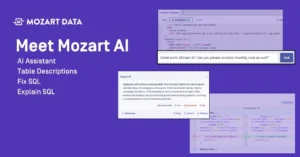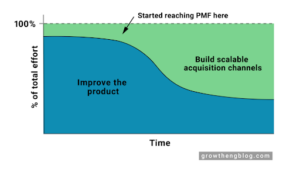Businesses today generate a large volume of data, and they need to make the most of the insights they gain from it to stay competitive. Data comes to businesses through all sorts of different sources, from sales and marketing to user experience. All of this must be combined with data from their various primary sources in order to be analyzed and for the business to fully understand what’s taking place in their organization.
The larger the business, the more data it generally has available. All this data can be used to make marketing more effective, build more useful products, better understand customers, and improve just about any other factor that affects profitability. Before any of that data can be used, though, it has to be extracted from those apps or internal sources so it can be cleaned, combined, and analyzed.

Defining Data Extraction
Data extraction is the process through which different kinds of data are retrieved from a wide variety of sources. For example, a healthcare company might pull data from internal cloud-based sources at headquarters, as well as local data from their clinics all around the country. This lets them streamline data from lots of different sources into one corpus their analysts can use to refine their processes, find efficiencies, or even to make sure all their data is preserved for compliance. Through data extraction, they can consolidate all of their data related to insurance claims, patient care, and healthcare providers in one warehouse.
Similarly, a big box retailer like Office Depot does business in physical stores and online. They might need to combine and analyze data from mobile apps, in-store inventory management systems, and their website. While those are all very different ways of moving products, and generate different kinds of data with different priorities, they all affect inventory, marketing, and the health of the corporation. It can be merged after extraction so that your data engineers can give decision makers a complete picture of what’s happening in the business. They can adjust their products or even their mode of delivery based on whatever they learn.
Your own business’ data might not be quite that complicated, or extensive – your marketing team might want to combine data from social media, pop up stores, and other marketing channels, leaving a lot of it unstructured. Extracting that data to a central warehouse where it can be cleaned and made more useful is a critical part of your data pipeline.
Through extraction, relevant data is located and identified. It’s then prepared for transformation, which enables analysts to mine the data and provide information that could be used to guide business decisions.
Data extraction is an important step in any data integration strategy. It’s the first stage in both Extract Transform Load (ETL) and Extract Load Transform (ELT). Extracted data may be stored in cloud-based or on-site locations. It can even be kept in a hybrid setting – but we recommend Snowflake for the price, security, and ease of use.
What Are the Types of Data Extraction?
There are two main types of data extraction. These are logical and physical, of which logical extraction can be further broken down into full and incremental extraction. Physical extraction is used in situations where it is the only option available.
Sometimes data systems may be outdated or have other limitations that make it difficult to draw data from them. Only physical extraction can get the data out. There are two types of physical extraction – offline and online extraction.
With online extraction, a connection is made directly to the source system in order to access the source tables. An external staging area is not required. With offline extraction, the data is taken from an external area that keeps a copy of the source.
With full extraction, all of the data is extracted at one time from the source. This means that, for example, if a company makes a change to its prices and that file has to be extracted, the entire source table with its financial records would be extracted.
Incremental extraction focuses on delta changes, so new information is recognized based on dates and times. This type of extraction picks up on changes that occur in the data. To facilitate this, engineers have to add extraction logic to the source systems first.
How Is Data Extracted?
The data extraction process involves stages, which help to protect the integrity of the data, ensuring that managers can make decisions that aren’t influenced by errors. In the first stage of the extraction process, the structure of the data has to be checked for changes.
The data’s structure could be changed in several ways. For example, a new table could be added to it. New columns could also be added to existing tables. All of these changes are dealt with programmatically. Afterwards, the target fields and tables are retrieved from the records.
When the appropriate data is extracted, it is loaded into a data warehouse. Amazon RedShift and other cloud data warehouses like Snowflake are popular options. The process that’s used for loading the data is different for each destination.
Data Extraction Tools
Data extraction tools automate the process of data extraction, thereby saving time while allowing businesses to respond faster to changes in their market. These tools are built to read different types of systems, including CRMs, databases, and ERPs. Structured, semi-structured, and even unstructured data can all be extracted with ease by using the tools that are available.
When the extraction tools find the appropriate data within each source, they collect it for processing. This lets business managers leverage all of their big data effectively. They can pull data on transactions that are taking place online in real time and combine this with sources like product databases, to understand exactly what’s happening in a particular area.
Some data extraction tools have started using web scraping, especially over the last few years. This is particularly true for those that use the ETL process. During web scraping, web pages are segmented so that relevant information can be extracted.
Web scraping relies on Robotic Process Automation and other types of automation technology, such as Artificial Intelligence (AI). Web scraping benefits companies in several ways. For example, they may be able to get customer information by using this technique.
Nowadays, a lot of information is shared on social media platforms. Information may also be made available through emails, so data extraction tools are built to gather data from all of these webpage-based sources. Data that informs your decisions may even be pulled from news pages, complementing that which is taken from your internal or external sources.
Some data extraction tools will be standalone solutions. More often, though, they’re included in ETL and ELT tools. However you choose to use them, they are always an important part of data management. They help you to make the process of obtaining your raw data much smoother, so you have less hassle and are less likely to miss or duplicate any data.
Using data extraction tools is also important because within any system, you want to ensure that you have repeatability built in. Extraction tools make this possible, allowing you to repeatedly carry out a process that works well for your business so you can predict the type of results that you’ll get without human error.
Automation is critical, since it allows businesses to build a system that works once and then enhance it, instead of reinventing the wheel. Gathering and analyzing data in order to improve decision making is critical to the success of any business. This is a process that needs to occur smoothly even when there are major shifts in the market. Automation ensures that there will always be consistency in the type and quality of the data that you use.
Fivetran
Over 2,000 companies currently use Fivetran to organize their data. This database integration service can be used with warehouses such as Snowflake, RedShift, and BigQuery. Customers of Fivetran can load data from different databases and SaaS tools into their data warehouse, making it simple to do analysis on a larger volume of data. Data connectors in this software can be set up in less than five minutes and they don’t require maintenance.
You can gain insights by using your production data, pulling data from challenging APIs, and improving the efficiency of engineers through its point and click replication functions. It can easily replicate all of your data for additional uses, including event logs, cloud applications, and databases. These will be converted into schema in your data warehouse that can be easily queried.
Fivetran also maintains all of these connectors, so any API changes will be handled by Fivetran to ensure your data is always flowing, consistent, and up to date.
You can use any business intelligence tool to query your database when you’re using Fivetran. This software can be used with Snowflake on Google Cloud Platform, AWS, and Microsoft Azure. Today’s business decisions are driven by data and Fivetran makes it easy for businesses to leverage all of the data that’s at their disposal.
How Mozart Data extracts your data using Fivetran
Mozart Data provides the best-in-class modern data stack that you need to consolidate, organize, and clean your data for analysis. We use Fivetran under the hood for extracting data from over 120 different databases and SaaS tools. In under an hour, you’ll be able to extract data from all your disparate sources, load it into a centralized warehouse, and start creating reports and dashboards.
Benefits of Using a Data Extraction Tool
While more and more businesses are looking for the best way to use data in order to gain an edge over their competitors, data extraction tools dramatically accelerate the process and let you get on with analysis faster. While other businesses are not focused so much on beating the competition, everyone wants to provide the best level of service that they can to their customers all across the world.
Data extraction tools allow businesses to pull data from every possible source quickly, helping them to gain insights on issues that are important to them. If a company wants to know whether sales have been impacted by a campaign on social media, they can utilize Fivetran and other data extraction tools to combine data from all of their social media channels and their sales channels.
Data extraction tools provide better understanding than manual methods of working with data in data lakes or data warehouses. You will immediately upgrade your data warehouse by using data extraction tools within them, since these tools make it possible for your warehouse to benefit from all types of sources.
The benefits of data extraction tools include:
Scaling easily
As organizations grow, the volume of data they need to analyze increases. Data extraction tools help these businesses and nonprofits to collect data even as they add another branch or start serving clients from a new website.
If these tools weren’t used, staff members would have to manually parse through all of the data in order to find what they’re looking for. That’s a frustrating and time-consuming process. It’s also not the most efficient or inspiring way to use your team’s time.
If you don’t use data extraction tools, your ability to leverage all of your data will always be limited by how quickly you can sort through it manually. With these tools, you can deploy more data for each query and respond quickly to any new developments in the market.
Improving efficiency
When you use data extraction tools, you’ll spend less time collecting data. Your system will specifically identify and collect data that’s relevant to your needs. Your business will reduce the time that’s required for processes that are driven by data. This in turn gives you more time to get insights from the data that you have.
Business process management
Data extraction can deliver customer information such as emails, phone numbers, and addresses. This helps businesses to serve their clients better. The information can then be placed in insurance forms and in other fields as required.
Control
Data extraction tools allow companies to reduce their reliance on data silos. They can use tools to identify the data that they actually need and pull it from diverse sources.
Accuracy
Data extraction tools allow complex data streams to be managed easily. User bias and human error are also removed, so more accurate data enters the rest of the system.
Usability
Data extraction tools are usually intuitive and provide users with a visual way of understanding the processes that are in place. Users don’t need to use programming to gain insights, so it makes it easy for more team members to use the system to answer questions about what is happening in their area.
Take the first step in making use of your data by using Mozart Data to extract it from all your data sources. Contact us to learn more.


